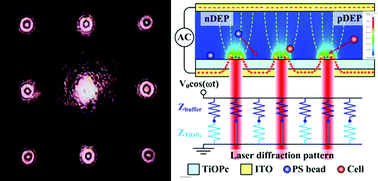Cell patterningvia diffraction-induced optoelectronic dielectrophoresis force on an organic photoconductive chip†
Abstract
A laser diffraction-induced

* Corresponding authors
a Department of Mechanical and Automation Engineering, Chinese University of Hong Kong, Hong Kong
b Department of Electrophysics, National Chiao-Tung University, Hsinchu, Taiwan 300, R.O.C.
c
Department of Power Mechanical Engineering, National Tsing Hua University, Hsinchu, Taiwan 300, R O.C.
E-mail:
liuch@pme.nthu.edu.tw
Tel: +886-3-5742496
A laser diffraction-induced

 Please wait while we load your content...
Something went wrong. Try again?
Please wait while we load your content...
Something went wrong. Try again?
S. Yang, S. Tseng, H. Chen, L. Hsu and C. Liu, Lab Chip, 2013, 13, 3893 DOI: 10.1039/C3LC50351H
To request permission to reproduce material from this article, please go to the Copyright Clearance Center request page.
If you are an author contributing to an RSC publication, you do not need to request permission provided correct acknowledgement is given.
If you are the author of this article, you do not need to request permission to reproduce figures and diagrams provided correct acknowledgement is given. If you want to reproduce the whole article in a third-party publication (excluding your thesis/dissertation for which permission is not required) please go to the Copyright Clearance Center request page.
Read more about how to correctly acknowledge RSC content.
 Fetching data from CrossRef.
Fetching data from CrossRef.
This may take some time to load.
Loading related content
